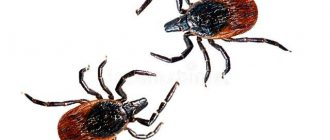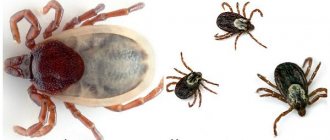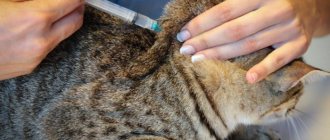Removing a tick is not always easy. If you followed our step-by-step guide to removing a tick and your cat is left with a stuck tick head, you need to know what to do. It is always advisable to speak to your veterinarian, who may ask you to bring your cat into the practice for a check-up.
If the head or mouthparts remain after removing the tick, do not panic. You have killed the tick and removed its body, preventing a serious risk of disease transmission. But any residual parts can still lead to infection at the attachment site.
Find out what you need to do to get rid of stubborn ticks once and for all.
What does the ixodid tick look like and what is dangerous?
Ixodid ticks belong to the class of arachnids. They have an oval brown body with four pairs of legs. The length of the female’s body in the hungry state does not exceed 4 mm. Males are smaller - about 2.5 mm in length. After saturation with blood, the parasite increases in size to 10–15 mm and acquires a light gray tint.
On the back of the insect there is a dense shield. The head is equipped with a proboscis with spikes that are directed towards the body. With its help, the tick pierces the skin of the victim and is firmly attached to it, so that it is not easy to pull it out.
When are ticks most active?
Ticks are activated when the thermometer rises to positive values. Their wintering takes place in the surface layers of the soil and in fallen leaves. Ixodid ticks cannot fly or jump, but simply sit on the grass or low bushes and wait for a cat, dog or person to pass by.
In direct contact with fur or clothing, mites cling to it with their paws, and then move closer to the body, guided by temperature.
Many people are mistaken when they think that a carrier of infection can only be picked up in a forest or park area with dense vegetation. In fact, mites are found wherever grass grows. Even in the city center, any person or pet can become a victim of arachnids.
Ticks are most active from early spring to early summer, as well as in August–September.
Diseases carried by ticks
Ticks are very dangerous as they are carriers of infectious diseases. These include:
- Hemobartonellosis is a cat disease in which anemia develops due to the death of red blood cells.
- Piroplasmosis is a deadly disease of cats and dogs caused by intracellular parasites.
- Anaplasmosis is more common in dogs than in cats. The disease is caused by intracellular bacteria and transmitted by ticks.
- Lyme disease affects dogs, cats, horses and humans.
- Tick-borne encephalitis (occurs in humans).
If the insect is not removed in time, there is a high probability that an infection will occur. Pathogenic bacteria and viruses are contained in the saliva and intestines of the bloodsucker.
How to detect a tick on an animal's body
Cats that are often outdoors should be examined daily. The easiest way to detect the carrier of the infection is when it has already sucked and drunk blood, since in this case it increases in size.
You should start your search where insects attach themselves most often:
- neck;
- ears;
- inner thighs;
- armpits;
- stomach.
In these places, the vessels are located close to the surface, and the skin is thin and easy to puncture. When examining a cat, you need to carefully part the fur, since the parasite is very small.
If you manage to find a tick, you should not stop searching - perhaps there is more than one tick on the cat.
If the carrier of the infection is not found during examination, this does not mean that it does not exist. Perhaps it has not yet attached itself, but is on the fur. It is advisable to comb the cat with a fine-toothed comb, sitting her on a white cloth. In this case, if the parasite falls out, it will not escape, because it will be clearly visible against a light background.
What to do with a tick?
Experts advise taking the caught tick to a laboratory, where it will be tested for carrier infections. It is clear that this is not necessary, but it is advisable:
- firstly, it will help to establish the epizootic situation in a specific area;
- secondly, the owner will know what to do with his four-legged friend if the tick suddenly turns out to be infectious.
Before shipping, the insect is placed in a container with a tightly screwed lid, which will not allow it to escape.
If there is no desire or opportunity to take the parasite anywhere for research, then it is destroyed by burning! There is no need to release the prisoner so that he does not attach himself to someone else.
How to remove ticks from a cat at home
If a parasite is found, it must be removed correctly. There are several ways to remove a tick:
- using insectoacaricidal drugs;
- mechanically.
Before removing a tick from a cat, you should wear rubber gloves in case the parasite gets crushed during the procedure.
If you need to remove a tick from a kitten, you need to act in the same way as when bitten by an adult pet. The only difference is that kittens have thinner and more delicate skin, so you should be more careful.
Using insectoacaricidal drops
If the parasite has recently attached itself, you can remove the tick from the cat using drugs with insectoacaricidal action. To do this, drop a few drops of the product onto it. After about 20-30 minutes, the tick falls off on its own. After the procedure, the wound is treated with iodine or another antiseptic.
List of insectoacaricidal drugs:
- Leopard;
- Binakar;
- Dana Ultra Neo.
You can use any drops whose instructions indicate that they act on ixodid ticks.
Mechanically
A tick that has attached itself several hours ago and has already drunk blood is more difficult to pull out. In this case, you will have to remove it mechanically. You need to act very carefully so as not to crush the parasite and tear off the head.
Tweezers
Before removing a tick from a cat's body, tweezers must be disinfected with chlorhexidine solution or medical alcohol. Next, the parasite is clamped at the very base of the head and slowly turned in any direction until the proboscis can be pulled out. It is important to pull it out very carefully so as not to crush the bloodsucker.
Special devices
The veterinary pharmacy sells special tools that can be used to safely remove the tick from the cat's body. They come in three types:
- Tick Twister Unclean hook. Outwardly, it is similar to a nail puller and differs only in its miniature size. The device is placed under the tick's body so that it is in the slot. Then rotate the hook in any direction and pull out the parasite.
- Trix Tix Lasso loop. It looks like a ballpoint pen with a button at the top. When you press it from below, a loop appears, which must be placed over the tick’s body as close to the cat’s skin as possible. With the help of a return mechanism, it is tightened and tightly clamps the parasite. Next, you need to pull it out with rotational movements.
- Pro Tick Plate. A very simple device for gripping a tick that resembles a bottle opener. The narrow part with the slot is placed under the parasite so as to press it close to the cat’s skin. To pull out an arthropod, you need to turn the plate to the right or left until the proboscis comes out.
Thread
Another way to remove a tick is with a thread. The abdomen of the parasite must be tied with a thick thread and then twisted. This method is not entirely safe. Often during the procedure, the torso is torn off, but the head remains in the skin.
Expert opinion
Chepa Natalya Semenovna
Veterinarian
Ask an expert
To unscrew the tick, you can use improvised means, for example, a clip from a bread package. To do this, you need to make a narrow wedge-shaped cut in it, then the device can be used as a pliers remover. If you managed to remove the entire tick, you need to place it in a container (you can use a sample collection container or a regular syringe) and deliver it to a veterinary laboratory. This is necessary to identify the parasite. After all, different types of ticks can be carriers of different diseases. There is no point in delivering a tick if it is not completely removed. Dangerous vector diseases such as babesiosis, anaplasmosis, and borreliosis are recorded much less often in cats than in dogs. However, where dogs suffer from these diseases, cats may well become infected as well.
Twisting technique
To prevent the head from coming off during the procedure and to carefully unscrew the tick, adhere to the following recommendations:
- immobilize the cat;
- grab the tick as close to the animal’s skin as possible;
- turn your body left or right until your head comes out.
It doesn't matter which way you rotate the parasite to get it out - clockwise or counterclockwise. It will be possible to remove it in any case, since when the body is rotated, the notches on the proboscis will change their position and the tick will come off.
Section question - answer
When it is necessary to remove a tick so that the head is not left under the skin, it is better to first clarify which actions are permissible and which are not, and what is best to use for this purpose. All questions can be asked to a specialist on the website online.
Is it more difficult to remove a tick from a kitten?
Inna Zaikovskaya, 26 years old, Penza: “I’m going to get a kitten, but we have a private house. I'm afraid of ticks. Tell me, is it easy to remove them from kittens?”
Expert opinion Oleg Viktorovich Veremeev Veterinarian, Doctor of Veterinary Sciences.
“The principle is the same for adult cats and kittens. When ticks are removed from small animals, they do not resist so much and they often do not need to be wrapped in a diaper. In this regard, it is even easier to remove parasites.”
Where does a cat that doesn't go outside get ticks?
Valeria Kuznetsova, 33 years old, Stary Oskol: “I’ve already had to remove ticks from a cat twice, but she lives in our apartment and doesn’t go outside. Where are they from?
Expert opinion Oleg Viktorovich Veremeev Veterinarian, Doctor of Veterinary Sciences.
“I can immediately tell you several reasons for the appearance of such pests: people bring them home on clothes, on other things or pets that are still at home (for example, dogs). Then the parasites look for shelter and, if possible, attack smaller animals.”
Inspect even cats that don't go outside
What to do if the head of the tick remains under the cat’s skin?
Varvara, 39 years old, Tula: “I tried to unscrew the parasite, but it came off. Now his head remains under the skin. Do I need to do anything?
Expert opinion Oleg Viktorovich Veremeev Veterinarian, Doctor of Veterinary Sciences.
“I still advise you to remove a fragment of the parasite’s body. If this is not done, inflammation will develop; the worst-case scenario for the development of such a situation is sepsis. The principle of removing a head from a cat's skin is simple. It resembles the technique of removing a splinter. When you decide what to do if the tick's head remains in the cat's body, you need to remember 2 things: make a fold in the pet's skin, and try to remove the protruding fragment with tweezers. If that doesn't work, use a sterile needle. Then try the tweezers again."
Do cats get vaccinations?
Karina Podzhukis, 40 years old, Tambov: “I want to vaccinate the animal, since I have already removed ticks twice this season. Do cats get vaccinations?
Expert opinion Oleg Viktorovich Veremeev Veterinarian, Doctor of Veterinary Sciences.
"No. Cats are not vaccinated against diseases carried by ticks, but dogs are. This is explained by the fact that cats tolerate piroplasmosis more easily. Such animals are vaccinated against rabies and various viral diseases not associated with tick bites.”
What colors can a tick be?
Irina Shvetsova, 38 years old, Samara: “I’m not sure that I found a tick on the animal’s body. Tell me what colors they come in?”
Expert opinion Evgeniy Igorevich Bragin Entomologist, 19 years of scientific experience.
“There is a wide variety: yellow-brown, gray, brown, dark red. These are shades of ixodid, argasid parasites, which are more often found in cats.”
Ticks are found not only in bright (orange) colors, but also in other colors
Are there anti-tick tablets for cats and kittens?
Anastasia Masliy, 36 years old, Penza: “I want to protect my cat from parasites for a long time. Tell me, are there such pills?”
Expert opinion Oleg Viktorovich Veremeev Veterinarian, Doctor of Veterinary Sciences.
“Yes, of course, there are some for sale. For example, Bravecto. But at my own discretion, I do not recommend using them. Contact your veterinarian for advice."
What to do if the tick comes off?
Alina Chumakova, 28 years old, Kazan: “For the first time I removed a tick from an animal using a thread. I couldn't buy a special hook. What are my next steps?
Expert opinion Oleg Viktorovich Veremeev Veterinarian, Doctor of Veterinary Sciences.
“You will have to further remove this fragment, since an abscess soon appeared in this place. Inflammation can lead to complications."
Can larvae (nymphs) be dangerous for cats?
Veronica Soboleva, 32 years old, St. Petersburg: “I found some kind of pest on my cat. Similar to a tick, but not as large. Could this be a larva? Is she dangerous?
Expert opinion Oleg Viktorovich Veremeev Veterinarian, Doctor of Veterinary Sciences.
“It is the nymphs that pose a danger to young cats, as well as adult animals. They choose small animals as hosts. Sexually mature ticks usually attack large animals, people, artiodactyls, and cattle.”
Tick larvae are just as dangerous to cats as adult ticks.
Common Mistakes
When removing ticks from cats, many people make serious mistakes. For example, they remove the parasite with their fingers or pour it with oil. If there is no device at hand that makes it easy to remove the tick, some cat owners try to do it with their hands. This is not the best idea - if you grab the body from both sides, you can easily crush the parasite. Then its contents will get into the wound. If the tick is infected, the cat will get sick.
Another mistake is to pour oil on it before removing a tick from a cat. Many people think that then the parasite will have nothing to breathe. The tick will actually suffocate under the oily film.
However, before he dies, he will regurgitate the contents of his intestines, which will end up in the wound. In this case, the risk of infection will increase several times. For this reason, you cannot use other oil-containing substances (gasoline, kerosene) to pull out the arachnid.
Actions after parasite removal
Immediately after removing the tick, the wound is filled with chlorhexidine, hydrogen peroxide or another antiseptic. You need to inspect it periodically. If the bite site turns red or festered, the cat should be taken to a veterinary clinic.
The removed tick should be placed in a vial, tightly capped and sent to the laboratory for examination. If this is not possible, then it is better to destroy the parasite by burning it. Do not throw the insect down the drain or crush it.
After removing the tick, you should thoroughly wash your hands with soap and wipe them with alcohol. This will help avoid contracting an infection.
It is important to monitor the cat's condition. Symptoms of the disease may not appear immediately, but 1–4 weeks after the parasite has been removed. The owner of the animal should be alert to:
- increased cat body temperature;
- lethargy;
- lack of appetite;
- blanching of the mucous membranes;
- bowel dysfunction;
- unkempt appearance of the coat.
All diseases that the ixodid tick carries are treatable. The main thing is to pull out the bloodsucker in time, and if symptoms of the disease are detected, immediately seek veterinary help. You should not hesitate if signs of infection are found in kittens. They have weak immunity, so the disease develops faster.
What to do with the cat?
After the tick is removed, the bite site must be treated with any antiseptic solution.
Subsequently, the animal is monitored for at least 3 weeks with home quarantine. Why is observation necessary? The fact is that most infections have a hidden or latent period, when the animal appears healthy, but the destructive activity of the pathogen has already begun in the body. If within 21 days the animal, God forbid, gets sick, then at least there will be something to start from when making a diagnosis.
To try to prevent the development of a viral or bacterial infection, you can take a course of immunoglobulins - this will increase immunity. But no one can give a guarantee that the animal will definitely not get sick from such prevention. Moreover, immune drugs do not work against blood parasites - their action is mainly aimed at helping the body produce antibodies to viruses.
Preventing tick attacks
Prevention includes regular examination of the pet, even if the cat does not go outside. Special means are used to protect domestic animals:
- Insectoacaricidal drops on the withers are considered the most effective. They are applied once a month. However, such drugs are not suitable for kittens under 2 months of age.
- Anti-tick sprays contain substances whose odor repels bloodsuckers. However, there is one drawback - after spraying, the animal can lick the toxic composition from the fur. To avoid troubles, it is better to apply it in the same place as the drops - on the withers.
- Another method of protection is a collar with an insectoacaricidal composition. It is absolutely safe even for small kittens.
If a cat goes out for a walk freely, the owner should be on alert - in spring and summer there is a high probability of picking up a tick. You need to make it a rule to examine your cat every day.
It is important to remove a discovered bloodsucker as quickly as possible. The sooner this is done, the less likely it is that your pet will become infected with an infectious disease.











